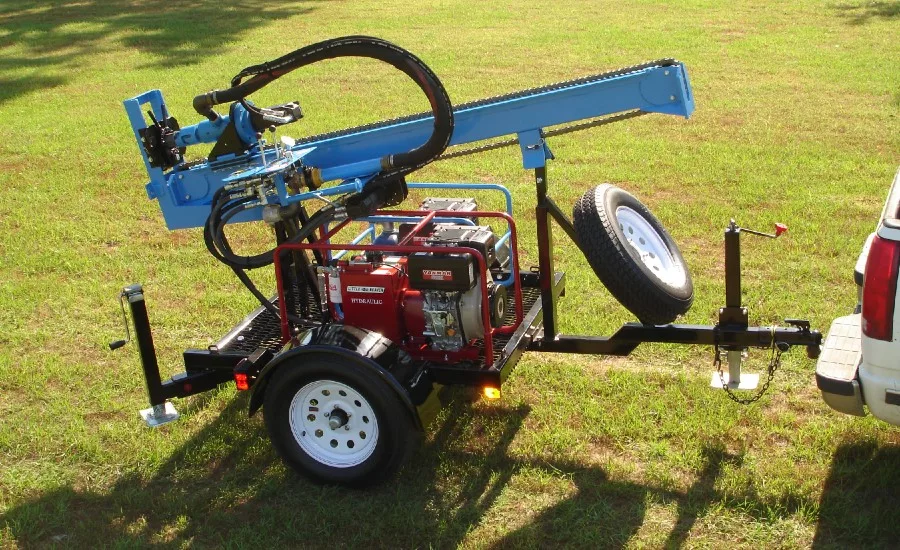Key Priorities for Building a Successful Drilling Operation
The Right Drill, Training and Quality Tooling All Contribute to Completion

Small, trailer-mounted drill rigs offer quick setup and operation.
Lone Star Drills
Water well drilling is an advanced process and requires more than just purchasing a drill and learning on the job. Drilling water wells efficiently and correctly requires researching site conditions, knowledge of the drill best suited for the job and knowing what drill qualities to look for. Training on drill operation and jobsite duties are also critical components of successful water well drilling operations. Before embarking on a drilling project, it’s prudent to consider some basic factors for drilling success.
Choosing a Drill
Small, portable water well drills are available in two basic categories, mechanical and hydraulic. To choose the best drill, determine the soil conditions and drilling depth at your typical drill site. Then, consider the relative advantages of each category.
Mechanical drills:
- Are excellent for drilling in sand, clay and loamy soils.
- Are best at 100- to 200-foot depths.
- Have minimal moving parts
- And are lightweight, portable and great for less-experienced drillers.
Hydraulic drills:
- Feature ample power for drilling through hard rock formations.
- Can reach 300- to 400-foot depths.
- Feature as much as 5,000 pounds of push-down force.
- And have trailer-mounted options for easy setup and portability.
Water well drillers face major expenses when drills can’t meet the challenges of a project’s location. Using a drill best suited for the soil conditions will minimize premature wear and reduce the risk of breakdowns, which can result in safety hazards. However, even if a drill is suited for the conditions, its crucial components may not be.
Quality Components
After determining the drill best suited for the environment, ensure the key drill components are of the highest quality. The best drill in the world can still leave water well drillers stuck in the mud if it uses low-quality water pipe that breaks easily instead of heavy-duty drill pipe. Look for manufacturers that provide actual drill pipe instead of water pipe on all their drills. Operators can use 1.25-inch drill pipe down to 100 feet, but need to choose at least 2-inch-diameter drill pipe for applications exceeding 100-foot depths.
The best drill in the world can still leave water well drillers stuck in the mud if it uses low quality water pipe that breaks easily instead of heavy-duty drill pipe.
Equipment is only half the equation though. Successfully navigating terrain and depths beyond 100 feet requires more than quality components. The team operating the drill needs to be well-trained and equipped with the skills and knowledge to help them succeed.
Training Now, Success Later
Proper training helps water well drillers become familiar with equipment, as well as the different roles on a drill site. Understanding the distinct roles of fellow drill team members ensures safe and efficient operation. Professional training developed by a drill manufacturer also provides a hands-on opportunity to view drilling equipment and learn safe operation procedures in a controlled environment. Look for a manufacturer that streamlines this process with training videos and customer support from industry experts.
Drilling Day Tips For Success
Once equipment is purchased and training is settled, drilling can begin. These final pointers will help build good habits and ensure success in your projects and business day in and day out.
- Drilling location: Before drilling, determine a safe well location with stable ground, low risk of contamination and convenient access. Some manufacturers also provide the equipment necessary for water well drillers to expand their operations into soil sampling. This can provide contractors with a complete site location preparation solution.
- Dress for success: When drilling, it’s important to dress appropriately. Wear work boots, hard hats and comfortable clothing that will not restrict movement. However, avoid anything loose that could get caught on moving parts.
- Maintenance: Regular maintenance is essential for preventing equipment damage and reducing downtime. Check equipment daily for proper lubrication to keep the operation running smoothly and prolong the life of the drill.
- Come prepared: Some manufacturers offer service kits stocked with common wear parts and tools to help operators complete repairs quickly and ensure nothing is left behind.
- Clean up: When drilling is complete, clean the equipment and drill site. Properly caring for the equipment and site saves time later and ensures a safe start for the next job.
Professional drillers know that it takes more than a drill and a few workers to become successful in this industry. Proper training, industry knowledge, and dedication to routine cleaning and maintenance will ensure a driller is prepared for anything and provide the foundation for future success.
Looking for a reprint of this article?
From high-res PDFs to custom plaques, order your copy today!




